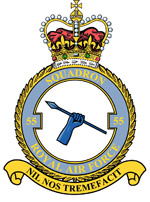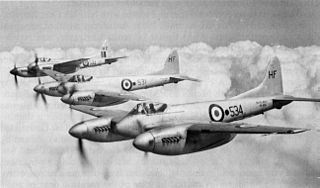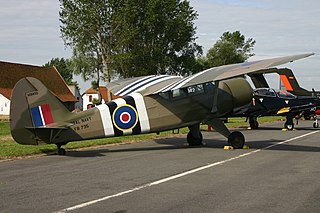
A liaison aircraft is a small, usually unarmed aircraft primarily used by military forces for artillery observation or transporting commanders and messages.

Hawker Siddeley was a group of British manufacturing companies engaged in aircraft production. Hawker Siddeley combined the legacies of several British aircraft manufacturers, emerging through a series of mergers and acquisitions as one of only two such major British companies in the 1960s. In 1977, Hawker Siddeley became a founding component of the nationalised British Aerospace (BAe). Hawker Siddeley also operated in other industrial markets, such as locomotive building and diesel engine manufacture. The company was once a constituent of the FTSE 100 Index.

The de Havilland DH.89 Dragon Rapide is a 1930s short-haul biplane airliner developed and produced by British aircraft company de Havilland. Capable of accommodating 6–8 passengers, it proved an economical and durable craft, despite its outdated plywood construction.

The British Aerospace 125 is a twinjet mid-size business jet. Originally developed by de Havilland and initially designated as the DH.125 Jet Dragon, it entered production as the Hawker Siddeley HS.125, which was the designation used until 1977. Later on, more recent variants of the type were marketed as the Hawker 800.

Whangārei Airport is an airport 4 nautical miles to the south east of Whangārei city, in the suburb of Onerahi, on the east coast of Northland in the North Island of New Zealand. The airport has a single terminal with two gates.

The Armstrong Siddeley Viper is a British turbojet engine developed and produced by Armstrong Siddeley and then by its successor companies Bristol Siddeley and Rolls-Royce Limited. It entered service in 1953 and remained in use with the Royal Air Force, powering its Dominie T1 navigation training aircraft until January 2011.

The Vickers Varsity is a retired British twin-engined crew trainer operated by the Royal Air Force from 1951 to 1976.

Number 55 Squadron was a flying squadron of the Royal Air Force (RAF). First formed in April 1917, the squadron saw action on the Western Front during the First World War. Based in the Middle East during the interwar period and the Second World War, No. 55 Squadron saw action over Iraq, Egypt, Libya and Italy. Between 1960 and 1993, the unit flew the Handley Page Victor. Initially on the Victor B.1A before becoming a tanker squadron in 1965 with the Victor B(K).1A/K.1/K.1A before converting to the Victor K.2 in 1975. Disbanding in October 1993, No. 55 Squadron were the last RAF unit to operate the Victor. Between 1996 and 2011, No. 55(Reserve) Squadron operated the Hawker Siddeley Dominie T.1 from RAF Cranwell, Lincolnshire, helping to train navigators for the RAF.
Domine is vocative of the Latin for "Lord!"

701 Naval Air Squadron was a Royal Navy Fleet Air Arm squadron, which last disbanded during September 1958 at RNAS Lee-on-Solent where it was a Helicopter Trials, Communications and Fleet Requirements Unit. It initially formed during July 1936 as a Catapult Flight operating out of Malta and routinely embarking in RN ships such as, HMS Barham, HMS Malaya, HMS Valiant and HMS Warspite. By autumn 1939 it was known as 701 Naval Air Squadron but disbanded in January 1940. It was active twice more during the Second World War, between May 1940 and June 1941 on special duties and then between October 1942 and August 1943 performing anti-submarine patrols. Reforming in April 1945 it was designated a Communications Unit, operating out of Heston until disbanding in 1947. It last reformed as a Fleet Requirements Unit at HMS Daedalus, Lee-on-Solent, during October 1957.
No. 526 Squadron of the Royal Air Force was a British Second World War calibration and communications squadron.
Kaikohe Aerodrome is an airfield south-east of Kaikohe in the Northland region of New Zealand. Built in 1942 as a US Marines bomber base, is the largest grass strip in the Southern hemisphere used now by general aviation. Other than powered aircraft, gliders use the airfield, and an area next to the runways is used by model airplane flyers. There are skydiving operations as well, with a landing spot near the old terminal.

No. 3 Flying Training School is a Royal Air Force military training school, which manages elementary flying training for the Royal Navy and Royal Air Force and also for the training of all non-pilot aircrew for the RAF and is home to the Central Flying School Tutor Squadron.

739 Naval Air Squadron was a Naval Air Squadron of the Royal Navy's Fleet Air Arm, which disbanded during 1950. It was formed as the Blind Approach Development Unit for the Fleet Air Arm, operating with Fairey Fulmar and Fairey Swordfish aircraft, at RNAS Lee-on-Solent, in 1942. Just under one year later the squadron moved to RNAS Worthy Down, in late 1943 and continued in the role. Roughly one year later the squadron moved again, relocating to RNAS Donibristle in late 1944, disbanding in 1945. It reformed in 1947 and was based at RNAS Culham, with a new role, as the Fleet Air Arm Photographic Trials and Development Unit.

740 Naval Air Squadron was a Naval Air Squadron of the Royal Navy's Fleet Air Arm. It was initially active between May and August in 1943, formed as an Observer Training Squadron at HMS Condor, RNAS Arbroath, Angus, Scotland. From December 1943 to September 1945 it was a Communications Squadron formed at and operated from HMS Landrail, at RNAS Machrihanish, Argyll and Bute, Scotland.

776 Naval Air Squadron was a Naval Air Squadron of the Royal Navy's Fleet Air Arm which last disbanded at the end of October 1945. 776 Naval Air Squadron formed as a Fleet Requirements Unit at HMS Daedalus, RNAS Lee-on-Solent, at the start of 1941. It operated a detachment at RN Air Section Speke in 1941 and one at RAF Woodvale in 1942, with the squadron wholly moving to Speke in the October. 1943 saw further detachments and these were deployed at RAF Llanbedr, RAF Millom, RAF Usworth and RAF Waltham. In April 1945, the Woodvale detachment was reabsorbed into the squadron when it relocated there, the airbase now operated by the Admiralty and known as HMS Ringtail II. It moved to HMS Ringtail, RNAS, Burscough, at the start of October 1945.

781 Naval Air Squadron was a Naval Air Squadron of the Royal Navy's Fleet Air Arm which disbanded at the end of March 1981. Planned as a Reserve Amphibious Bomber Reconnaissance squadron, it formed as a Communications Unit in March 1940 and operated a large variety of aircraft. It provided a Bristol Beaufighter conversion course which eventually became 798 Naval Air Squadron and also had a ‘B’ Flight at Heathrow and then Heston aerodromes before becoming 701 Naval Air Squadron. After the Allied invasion of Normandy the squadron flew to various Royal Navy units on the continent and established an ‘X’ Flight based in France and then Germany. In July 1945 the squadron disbanded into 782 Naval Air Squadron although the ‘X’ Flight was moved to 799 Naval Air Squadron.

782 Naval Air Squadron was a Naval Air Squadron of the Royal Navy's Fleet Air Arm. It initially formed in October 1939 as an Armament Training Squadron but disbanded in November to provide personnel for 774 Naval Air Squadron. In December 1940 it reformed at HMS Merlin, RNAS Donibristle, as the Northern Communications Squadron, providing links between the Naval Air Stations in Scotland, Northern Ireland, and the Shetland and Orkney islands. It finally disbanded in October 1953.

790 Naval Air Squadron was a Naval Air Squadron of the Royal Navy's Fleet Air Arm which disbanded in November 1949 at RNAS Culdrose. It initially formed during 1941 as an Air Target Towing Unit, at HMS Landrail, RNAS Macrihanish, in Scotland, from elements of two other Fleet Air Arm squadrons, however, this only lasted for three months and the unit was disbanded, absorbed into 772 Naval Air Squadron. It reformed the following year, in July 1942, tasked as a Fighter Direction Training Unit, at RNAS Charlton Horethorne. It provided support for the Fighter Direction School and had short spells at RAF Culmhead and RNAS Zeals, before reloacting to RNAS Dale in Pembrokeshire, next to the new purpose built Air Direction School, HMS Harrier or RNADC Kete, in 1945. The squadron moved to HMS Seahawk in Cornwall during December 1947.
No. 6 Flying Training School RAF is a Flying Training School (FTS) within No. 22 (Training) Group of the Royal Air Force that delivers flying training to University Air Squadrons and Air Experience Flights.















